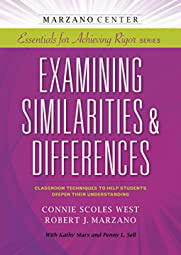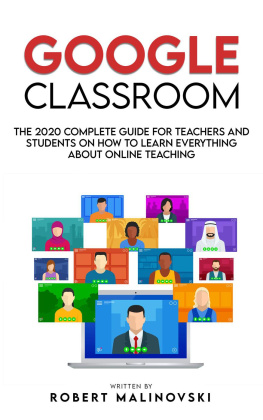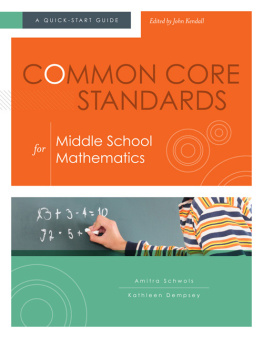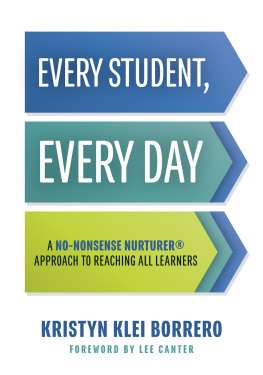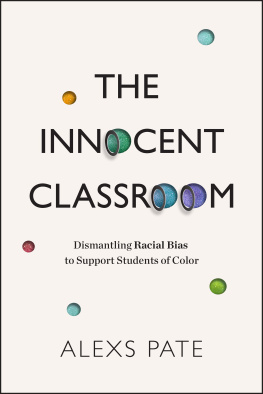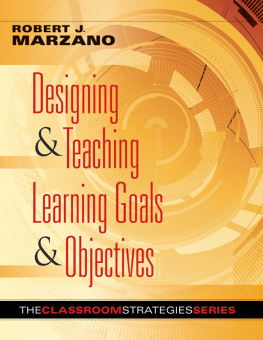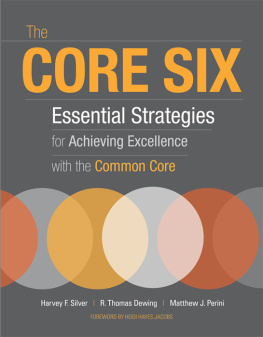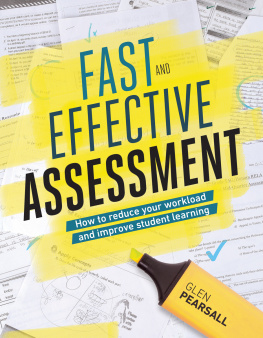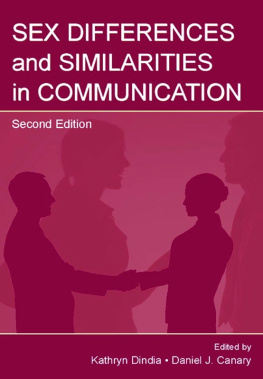EXAMINING
SIMILARITIES &
DIFFERENCES
CLASSROOM TECHNIQUES
TO HELP STUDENTS
DEEPEN THEIR
UNDERSTANDING
EXAMINING
SIMILARITIES &
DIFFERENCES
CLASSROOM TECHNIQUES
TO HELP STUDENTS
DEEPEN THEIR
UNDERSTANDING
Connie Scoles West and Robert J. Marzano
With Kathy Marx and Penny L. Sell
Copyright 2015 by Learning Sciences International
All rights reserved. Tables, forms, and sample documents may be reproduced or displayed only by educators, local school sites, or nonprofit entities who have purchased the book. Except for that usage, no part of this book may be reproduced, transmitted, or displayed in any form or by any means (photocopying, digital or electronic transmittal, electronic or mechanical display, or other means) without the prior written permission of the publisher.
1400 Centrepark Blvd, Suite 1000
West Palm Beach, FL 33401
717-845-6300
email:
learningsciences.com
Printed in the United States of America
20 19 18 17 16 15 2 3 4
Publishers Cataloging-in-Publication Data
Scoles West, Connie.
Examining similarities & differences : classroom techniques to help students deepen their understanding / Connie Scoles West [and] Robert J. Marzano.
pages cm. (Essentials for achieving rigor series)
ISBN: 978-1-941112-05-2 (pbk.)
1. Thought and thinkingStudy and teaching. 2. Critical thinkingStudy and teaching. 3. Effective teachingUnited States. 4. Metaphor. 5. Analogy. I. Marzano, Robert J. II. Title.
LB1060 .S383 2015
370.15dc23
[2014939270]
The Essentials for Achieving Rigor series of instructional guides helps educators become highly skilled at implementing, monitoring, and adapting instruction. Put it to practical use immediately, adopting day-to-day examples as models for application in your own classroom.
Books in the series:
Identifying Critical Content: Classroom Techniques to Help Students Know What Is Important
Examining Reasoning: Classroom Techniques to Help Students Produce and Defend Claims
Recording & Representing Knowledge: Classroom Techniques to Help Students Accurately Organize and Summarize Content
Examining Similarities & Differences: Classroom Techniques to Help Students Deepen Their Understanding
Processing New Information: Classroom Techniques to Help Students Engage with Content
Revising Knowledge: Classroom Techniques to Help Students Examine Their Deeper Understanding
Practicing Skills, Strategies & Processes: Classroom Techniques to Help Students Develop Proficiency
Engaging in Cognitively Complex Tasks: Classroom Techniques to Help Students Generate & Test Hypotheses across Disciplines
Using Learning Goals & Performance Scales: How Teachers Make Better Instructional Decisions
Organizing for Learning: Classroom Techniques to Help Students Interact within Small Groups
Table of Contents
Acknowledgments
I would like to thank my colleagues from Learning Sciences International who have done so much to provide guidance and opportunities. Many thanks to Michael Toth, Bryan Toth, and Beverly Carbaugh, and to my fellow staff developers who are a constant source of help and support for me.
In addition, I must recognize all the wonderful school administrators and teachers who have been participants in my sessions. They are the source of many of the ideas and examples in this book. Finally, I want to acknowledge Paul West, extraordinary teacher and husband, who patiently listens, shares, serves as a sounding board, and always supports.
Connie Scoles West
Learning Sciences International would like to thank the following reviewers:
Kristi Bundy | Jamie Manker |
2014 Nebraska Teacher of the Year | 2014 Missouri Teacher of the Year |
Ashland-Greenwood Public Schools | Rockwood Summit High School |
Ashland, Nebraska | Fenton, Missouri |
Jennie Dearani Calnan 2014 New Hampshire Teacher of the Year finalist District Literacy Plan Coordinator Reading Specialist Monadnock Regional School District Swanzey, New Hampshire Maureen Look 2011 Wisconsin Teacher of the Year Eighth-Grade Science and Engineering Educator Milwaukee, Wisconsin | Barbara Rosolino 2013 Georgia Teacher of the Year finalist Eagles Landing High School McDonough, Georgia Tracie Wagenfeld 2014 Maine Teacher of the Year finalist Fifth-Grade Teacher Willard School Sanford, Maine |
About the Authors
CONNIE SCOLES WEST, BSEd, MEd, spent her career in K12 education as a classroom teacher and administrator in Cincinnati, Ohio, before joining Learning Sciences International as an independent staff developer in 2012. Connie brings expertise to her work from years of experience in a broad spectrum of leadership roles, including gifted education, mentoring, instructional coaching, school improvement, curriculum, professional development, and teacher evaluation. She has presented at numerous conferences on topics in literacy, mathematics, coaching, and curriculum and instruction. Connie earned bachelors and masters degrees in education from Miami University in Oxford, Ohio.
ROBERT J. MARZANO, PhD, is CEO of Marzano Research Laboratory and Executive Director of the Learning Sciences Marzano Center for Teacher and Leader Evaluation. A leading researcher in education, he is a speaker, trainer, and author of more than 150 articles on topics such as instruction, assessment, writing and implementing standards, cognition, effective leadership, and school intervention. He has authored over 30 books, including The Art and Science of Teaching (ASCD, 2007) and Teacher Evaluation That Makes a Difference (ASCD, 2013).
KATHLEEN MARX, MSEd (Educational Leadership), MSEd (School Counseling), is a leading expert in personal development across industries. She has successfully assisted many districts nationally to implement deep school-improvement changes through her work with Learning Sciences International.
PENNY SELL, MSEd, has spent more than 30 years in public education, and her roles have included teacher, administrator, trainer, and consultant. She earned her bachelors degree in exceptional education from Central Michigan University and masters degree in educational leadership from the University of Central Florida.
Introduction
This guide, Examining Similarities & Differences: Classroom Techniques to Help Students Deepen Their Understanding , is intended as a resource for improving a specific strategy of instructional practice: examining similarities and differences.
Your motivation to incorporate this strategy into your instructional toolbox may have come from a personal desire to improve your instructional practice through the implementation of a research-based set of strategies (such as those found in the Marzano instructional framework) or a desire to increase the rigor of the instructional strategies you implement in your classroom so that students meet the expectations of demanding standards such as the Common Core State Standards, Next Generation Science Standards, C3 Framework for Social Studies State Standards, or state standards based on or influenced by College and Career Readiness Anchor Standards.

